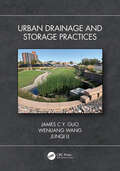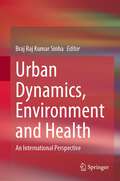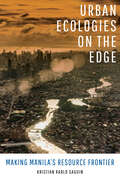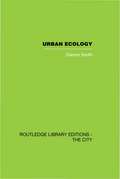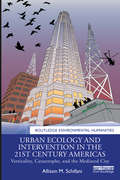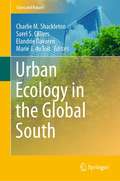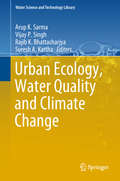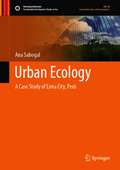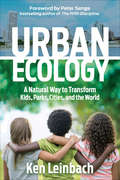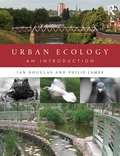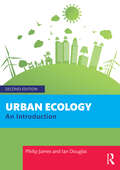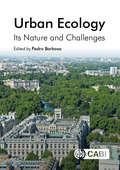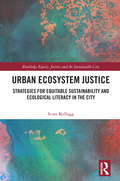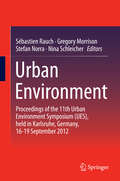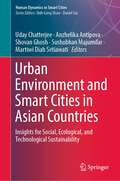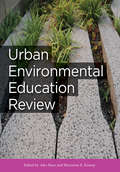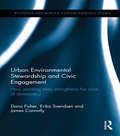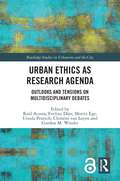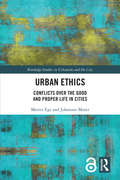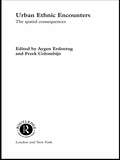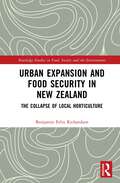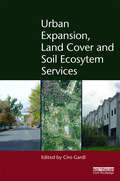- Table View
- List View
Urban Drainage and Storage Practices
by James C.Y. Guo Wenliang Wang Junqi LiUrban Drainage and Storage Practices focuses on the latest developments in urban stormwater design methods using drainage and storage approaches for both water quality and quantity control. It covers both the conventional approaches to flood mitigation and low-impact methods for stormwater quality enhancement. Theory, practice, and modeling methods are presented to illustrate how to build a holistic stormwater drainage and storage system using urban open space and parks through multiple land use. Each chapter provides background theory, numerical experiments, illustrations, and Excel spreadsheets that outline design and calculation procedures. All urban watersheds are modeled as a series of cascading planes to drain stormwater from upstream roofs and parking lots onto downstream grass areas and vegetal beds. The drainage system is designed as a three-layer cascading system with various low-impact units for micro events, conveyance elements for minor events, and storage facilities for macro events. This book: presents the theory and practice of designing and building a stormwater system explains green approaches to designing and managing urban stormwater systems. This text is ideal for senior and graduate students studying urban hydrology, hydraulic engineering, and water resource management. It will also be useful for engineers requiring a technical book with hands-on practical examples.
Urban Dynamics, Environment and Health: An International Perspective
by Braj Raj Kumar SinhaThe comprehensive volume focuses on spatial, temporal, conceptual and empirical approaches to various elements of urban dynamics, environment and urban health. It demonstrates a multidisciplinary account of the significant dimensions of urbanization and urban life. Chapters by leading international experts are presented in sections on urban dynamics, Urban Environmental Issues, Urban Health Problems and Urban Development, Planning and Policies. Each chapter provides a breadth of information on conceptual and empirical studies of urban issues. It enables the readers to understand the interconnections of various vital elements of each urban-related topical issue locally, regionally and globally. Extensive maps, charts, diagrams and tables as cartographic tools facilitate the reader’s understanding. It also outlines an action plan for policy program change in both the developed and less developed countries toward sustainable urban development and environment for better health, prosperity and quality of life of the present and future urban population. It is an indispensable reference for students, research scholars of geography and environmental, medical, and social sciences at undergraduate and postgraduate levels.
Urban Ecologies on the Edge: Making Manila's Resource Frontier
by Kristian Karlo SaguinLaguna Lake, the largest lake in the Philippines, supplies Manila's dense urban region with fish and water while operating as a sink for its stormflows and wastes. Transforming the lake to deliver these multiple urban ecological functions, however, has generated resource conflicts and contradictions that unfold unevenly across space. In Urban Ecologies on the Edge, Kristian Karlo Saguin tracks the politics of resource flows and unpacks the narratives of Laguna Lake as Manila's resource frontier. Provisioning the city and keeping it safe from floods are both frontier-making processes that bring together contested socioecological imaginaries, practices, and relations. Combining fieldwork and historical accounts, Saguin demonstrates how people—powerful and marginalized—interact with the state and the environment to produce the unequal landscapes of urbanization at and beyond the city's edge.
Urban Ecology
by Dianne SmithThere are many micro-habitats in built up areas, often subject to strong environmental pressures such as atmospheric and water pollution, frequent disturbance, trampling, nutrient or water scarcity, etc. In Urban Ecology Dianne Smith uses such features as footpaths, walls, gravestones, gardens, compost heaps and derelict land to investigate the effects of these pressures and to demonstrate other ecological properties of oftern isolated habitats. This book was first published in 1984.
Urban Ecology
by Richard T. T. FormanHow does nature work in our human-created city, suburb, and exurb/peri-urb? Indeed how is ecology - including its urban water, soil, air, plant, and animal foundations - spatially entwined with this great human enterprise? And how can we improve urban areas for both nature and people? Urban Ecology: Science of Cities explores the entire urban area: from streets, lawns, and parks to riversides, sewer systems, and industrial sites. The book presents models, patterns, and examples from hundreds of cities worldwide. Numerous illustrations enrich the presentation. Cities are analyzed, not as ecologically bad or good, but as places with concentrated rather than dispersed people. Urban ecology principles, traditionally adapted from natural-area ecology, now increasingly emerge from the distinctive features of cities. Spatial patterns and flows, linking organisms, built structures, and the physical environment highlight a treasure chest of useful principles. This pioneering interdisciplinary book opens up frontiers of insight, as a valuable source and text for undergraduates, graduates, researchers, professionals and others with a thirst for solutions to growing urban problems.
Urban Ecology and Intervention in the 21st Century Americas: Verticality, Catastrophe, and the Mediated City (Routledge Environmental Humanities)
by Allison M. SchifaniThis book takes a hemispheric approach to contemporary urban intervention, examining urban ecologies, communication technologies, and cultural practices in the twenty-first century. It argues that governmental and social regimes of control and forms of political resistance converge in speculation on disaster and that this convergence has formed a vision of urban environments in the Americas in which forms of play and imaginations of catastrophe intersect in the vertical field. Schifani explores a diverse range of resistant urban interventions, imagining the city as on the verge of or enmeshed in catastrophe. She also presents a model of ecocriticism that addresses aesthetic practices and forms of play in the urban environment. Tracing the historical roots of such tactics as well as mapping their hopes for the future will help the reader to locate the impacts of climate change not only on the physical space of the city, but also on the epistemological and aesthetic strategies that cities can help to engender. This book will be of great interest to students and scholars of Urban Studies, Media Studies, American Studies, Global Studies, and the broad and interdisciplinary field of Environmental Humanities.
Urban Ecology for Citizens and Planners
by Gail Hansen Joseli MacedoIdeal for city residents, developers, designers, and officials looking for ways to bring urban environments into harmony with the natural world and make cities more sustainable, Urban Ecology for Citizens and Planners offers a wealth of information and examples that will answer fundamental scientific questions, guide green initiatives, and inform environmental policies and decision-making processes. This book provides an overview of the synergistic relationships between humans and nature that shape the ecology of urban green spaces. It also emphasizes the social and cultural value of nature in cities for human health and well-being. Chapters describe the basic science of natural components and ecosystems in urban areas and explore the idea of biophilic urbanism, the philosophy of building nature into the framework of cities. To illustrate these topics, chapters include projects, case studies, expert insights, and successful citizen science programs from urban areas around the world. Authors Gail Hansen and Joseli Macedo argue that citizens have increasingly important roles to play in the environmental future of the cities they live in. A valuable resource for real-world solutions, this volume encourages citizens and planners to actively engage and collaborate in improving their communities and quality of life.
Urban Ecology in the Global South (Cities and Nature)
by Charlie M. Shackleton Sarel S. Cilliers Elandrie Davoren Marié J. du ToitAgainst the background of unprecedented rates of urbanisation in the Global South, leading to massive social, economic and environmental transformations, this book engages with the dire need to understand the ecology of such settings as the foundation for fostering sustainable and resilient human settlements in contexts that are very different to the Global North. It does so by bringing together scholars from around the world, drawing together research and case studies from across the Global South to illustrate, in an interdisciplinary and comprehensive fashion, the ecology of towns and cities in the Global South. Framed using a social-ecological systems lens, it provides the reader with an in-depth analysis and understanding of the ecological dynamics and ecosystem services and disservices within the complex and rapidly changing towns and cities of the Global South, a region with currently scarce representation in most of the urban ecology literature. As such the book makes a call for greater geographical balance in urban ecology research leading towards a more global understanding and frameworks. The book embraces the complexity of these rapid transformations for ecological and environmental management and how the ecosystems and the benefits they provide shape local ecologies, livelihood opportunities and human wellbeing, and how such knowledge can be mobilised towards improved urban design and management and thus urban sustainability.
Urban Ecology, Water Quality and Climate Change (Water Science and Technology Library #84)
by Vijay P. Singh Arup K. Sarma Suresh A. Kartha Rajib K. BhattacharjyaThis unique book brings together high-quality research contributions on ecological aspects of urbanization, water quality concerns in an urban environment, and climate change issues with a strong Indian focus under one umbrella. It includes several case studies that discuss urban water management, particularly highlighting the quality aspects. Urbanization is an ecological disturbance that the modern world accepts as essential in the absence of a better alternative that could provide an equal level of comfort. The prohibitive costs of eco-friendly production technologies are forcing the developing world to generate industrial waste that is detrimental to the environment. At the same time, the availability of adequate fresh water is another challenge for our climate-change impacted world. The scientific community is, therefore, searching for ways towards ecologically sustainable urban development. Discussing all these issues, this book offers a useful guide for academicians, researchers, practicing engineers, and managers dealing with diverse water-related problems in urban areas.
Urban Ecology: A Case Study of Lima City, Perú (Sustainable Development Goals Series)
by Ana SabogalThis book emphasizes the necessity of green spaces and landscape planning to achieve a liveable city. It will more specifically enquire on how to reach a better liveability from the current conditions of Lima. This book takes on the one hand classic concepts from urban agronomy as are soil, water and plants, and on the other hand emphasizes the resources, the plant adaptations and the urban ecosystems, according to the context of Lima. Comparisons are also made to landscape concepts from other cities of the word, contemporary methods of urban landscape research are explained in perspectives of agronomy and ecology. The ecological restoration of some natural spaces of Lima are proposed and related to the food security which impacts on the sustainability of the city. Finally, it describes representative Parks of Lima and previous research projects that have allowed to improve the urban landscape. Considering the city's cultural diversity, comparisons to the mountain and rainforest areas are also made.
Urban Ecology: A Natural Way to Transform Kids, Parks, Cities, and the World
by Ken LeinbachWith climate change in the news, an urban core that has reached boiling point, and many children growing up without role models and with limited dreams, where is hope? There is a quiet experiment in Milwaukee that is turning heads. It starts with the simplicity of getting a city kid exploring their neighborhood park. How is it that so much life, community, and opportunity can grow from this unlikely soil? It's been called a miracle. It's contagious. It's spreading. It's exciting. And it works! This is the story of a group of ordinary people in a neighborhood who created something extraordinary. Readers will discover… the power of getting a city kid outside in nature; that kindness does work; how to say no while following the yes; the value of clarity and focus; how to find abundance within their own diverse community by simply and humbly asking for help; ten tried and tested rules for raising money (a lot of it!) while having a ton of fun doing it; a positive, believable, and very real vision for the future of the environment (we've got this!); and... how to join the Urban Ecology movement.
Urban Ecology: An Introduction
by Ian Douglas Philip JamesUrban Ecology: An Introduction seeks to open the reader’s mind and eyes to the way in which nature permeates everyday urban living, and how it has to be understood, cared for, and managed in order to make our towns and cities healthier places to visit and in which to live and work. The authors examine how nature can improve our physical and mental health, the air we breathe and the waters we use, as well as boosting our enjoyment of parks and gardens. Urban Ecology sets out the science that underlies the changing natural scene and the tools used to ensure that cities become both capable of adapting to climate change and more beautiful and resilient. The book begins with a discussion of the nature of urban places and the role of nature in towns and cities. Part 1 looks at the context and content of urban ecology, its relationship to other foci of interest within ecology and other environmental sciences, and the character of city landscapes and ecosystems. In Part 2 the authors set out the physical and chemical components of urban ecosystems and ecological processes, including urban weather and climate, urban geomorphology and soils, urban hydrology and urban biogeochemical cycles. In Part 3 urban habitats, urban flora and fauna, and the effects of, deliberate and inadvertent human action on urban biota are examined. Part 4 contains an exploration of the identification and assessment of ecosystem services in urban areas, emphasising economic evaluation, the importance of urban nature for human health and well-being, and restoration ecology and creative conservation. Finally, in Part 5 the tasks for urban ecologists in optimising and sustaining urban ecosystems, providing for nature in cities, adapting to climate change and in developing the urban future in a more sustainable manner are set out. Within the 16 chapters of the book – in which examples from around the world are drawn upon - the authors explore current practice and future alternatives, set out procedures for ecological assessment and evaluation, suggest student activities and discussion topics, provide recommended reading and an extensive bibliography. The book contains more than 150 tables and over 150 photographs and diagrams.
Urban Ecology: An Introduction
by Ian Douglas Philip JamesThis fully revised second edition reflects the great expansion in urban ecology research, action, and teaching since 2015. Urban ecology provides an understanding of urban ecosystems and uses nature-based techniques to enhance habitats and alleviate poor environmental conditions. Already the home to the majority of the world’s people, urban areas continue to grow, causing ecological changes throughout the world. To help students of all professions caring for urban areas and the people, animals, and plants that live in them, the authors set out the environmental and ecological science of cities, linkages between urban nature and human health, urban food production in cities, and how we can value urban nature. The authors explore our responsibilities for urban nature and greening, ecological management techniques, and the use of nature-based solutions to achieve a better, more sustainable urban future and ensure that cities can climate change and become more beautiful and more sustainable places in which to live. This text provides the student and the practitioner with a critical scientific overview of urban ecology that will be a key source of data and ideas for studies and for sound urban management.
Urban Ecology: Its Nature and Challenges
by Steven Frank Pedro Barbosa Aaron M Grade Adam J Terando Amanda E Sorensen Dennis VanEngelsdorp Elsa Youngsteadt Desiree L Narango Gail A Langellotto Heidi Liere Holly Martinson Ignacio Castellanos Iriana Zuria John G Kelcey Katherine Straley Lea Johnson Lindsay Miller Barranco Lisa Kuder Michael J Raupp Monika Egerer Nancy B Grimm Nancy Falxa Sonti Paige S Warren Rebecca C Jordan Riley Andrade Steward T Pickett Susannah B LermanToday, 55% of the world's human population lives in urban areas. By 2030, up to 90% of the global human population will live in cities and the global population is expected to increase by 68% by 2050. Although land cover categorized as "urban" is a relatively small fraction of the total surface of the Earth, urban areas are major driving forces in global environmental change, habitat loss, threats to biodiversity, and the loss of terrestrial carbon stored in vegetation biomass. These and many other factors highlight the need to understand the broad-scale impacts of urban expansion as it effects the ecological interactions between humans, wildlife and plant communities. In a series of essays by leading experts this book defines urban ecology, and provides much-needed focus on the main issues of this increasingly important subdiscipline such as the impacts of invasive species, protecting pollinators in urban environments, the green cities movement and ecological corridors. The book stresses the importance of understanding ecological forces and ecosystem services in urban areas and the integration of ecological concepts in urban planning and design. The creation of urban green spaces is critical to the future of urban areas, enhancing human social organization, human health and quality of life. Urban ecology is becoming a foundational component of many degree programs in universities worldwide and this book will be of great interest to students and researchers in ecology and conservation science, and those involved in urban planning and urban environmental management.
Urban Ecosystem Justice: Strategies for Equitable Sustainability and Ecological Literacy in the City (Routledge Equity, Justice and the Sustainable City series)
by Scott KelloggMerging together the fields of urban ecology, environmental justice, and urban environmental education, Urban Ecosystem Justice promotes building fair, accessible, and mutually beneficial relationships between citizens and the soils, water, atmospheres, and biodiversity in their cities. This book provides a framework for re-centering issues of justice and fairness in sustainability discourse while challenging the profound ecological alienation experienced by urban residents. While the urban sustainability movement has had many successes in the past few decades, there remain areas for it to grow. For one, the benefits of sustainability have disproportionately benefited wealthier city residents, with concerns over equity, justice, and social sustainability frequently taking a back seat to economic and environmental considerations. Additionally, many city dwellers remain estranged from and unfamiliar with ecological processes, with urban environments often thought of as existing outside of nature or as hopelessly degraded. Through a citizen-centered lens, the book offers a guide to reconciling these issues by demonstrating how questions of equity, access, and justice apply to the biophysical dimensions of the urban ecosystem: soil, water, air, waste, and biodiversity. Drawing heavily from the fields of urban ecology, environmental justice, and ecological design, this book lays out a science of cities for people: a pedagogical platform that can be used to promote ecological literacy in underrepresented urban communities through affordable and decentralized means. This book provides both a theoretical and practical field guide to students and researchers of urban sustainability, city planners, architects, policymakers, and activists wishing to develop reciprocal relationships with urban ecologies.
Urban Ecosystems
by Frederick R. Adler Colby J. TannerAs humans have come to dominate the earth, the ideal of studying and teaching ecology in pristine ecosystems has become impossible to achieve. Our planet is now a mosaic of ecosystems ranging from the relatively undisturbed to the completely built, with the majority of people living in urban environments. This accessible introduction to the principles of urban ecology provides students with the tools they need to understand these increasingly important urban ecosystems. It builds upon the themes of habitat modification and resource use to demonstrate how multiple ecological processes interact in cities and how human activity initiates chains of unpredictable unintended ecological consequences. Broad principles are supported throughout by detailed examples from around the world and a comprehensive list of readings from the primary literature. Questions, exercises and laboratories at the end of each chapter encourage discussion, hands-on study, active learning, and engagement with the world outside the classroom window.
Urban Environment
by Sébastien Rauch Gregory Morrison Stefan Norra Nina SchleicherOver half of the global population now lives in cities. This ongoing urbanisation is making it increasingly important to adequately manage urban systems and preserve urban environments. This book is the outcome of the 11th Urban Environment Symposium (UES) held on 16-19 September 2012 in Karlsruhe, Germany. The UES aims at providing a forum on the sciences and practices needed to promote a sustainable future in urban environments. Papers by leading experts are presented in sections on Urban Management and Spatial Planning, Green Cities and Urban Ecosystems, Urban Planning and Development, Air Quality and Noise, Urban Climate Change and Adaptation, and Contamination of Urban Waters and its Effects.
Urban Environment and Smart Cities in Asian Countries: Insights for Social, Ecological, and Technological Sustainability (Human Dynamics in Smart Cities)
by Anzhelika Antipova Uday Chatterjee Sushobhan Majumdar Martiwi Diah Setiawati Shovan GhoshThis book offers a thorough description of the challenges posed by increasing global urbanization. In addition, comprehensive perspectives are offered on how the contemporary urban challenges of our time are tackled by existing designers, architects, urban planners, and landscape architects thereby considering climate change, migration, resilience, politics, and environmental degradation. It includes insights from environmental design, geography, strategic planning, and engineering design. It goes beyond the jargon of technical innovation, and exposes the political, social and physical effects of digitalizing the world in smart cities. The book focuses on the application of geospatial technology of smart cities – including system design for basic services, real-time control and the Internet of Things. It highlights the planning of land use, strategic development, and ecosystem-based knowledge to enhance economic growth and healthy urban environment and smart city management. The book also shows the contradictory aspects of smart city studies, and provides useful insights into the creation and execution of policies to strengthen decision-making processes in smart cities. This book leads the reader to a greater understanding of smart city growth, both theoretical and realistic and as such it provides an interesting read for urban geographers, urban designers and planners, environmental specialists, practitioners, students.
Urban Environmental Education Review (Cornell Series in Environmental Education)
Urban Environmental Education Review explores how environmental education can contribute to urban sustainability. Urban environmental education includes any practices that create learning opportunities to foster individual and community well-being and environmental quality in cities. It fosters novel educational approaches and helps debunk common assumptions that cities are ecologically barren and that city people don't care for, or need, urban nature or a healthy environment.Topics in Urban Environmental Education Review range from the urban context to theoretical underpinnings, educational settings, participants, and educational approaches in urban environmental education. Chapters integrate research and practice to help aspiring and practicing environmental educators, urban planners, and other environmental leaders achieve their goals in terms of education, youth and community development, and environmental quality in cities.The ten-essay series Urban EE Essays, excerpted from Urban Environmental Education Review, may be found here: naaee.org/eepro/resources/urban-ee-essays. These essays explore various perspectives on urban environmental education and may be reprinted/reproduced only with permission from Cornell University Press.
Urban Environmental Stewardship and Civic Engagement: How planting trees strengthens the roots of democracy (Routledge Explorations in Environmental Studies)
by Dana R. Fisher Erika S. Svendsen James ConnollyOnce considered the antithesis of a verdant and vibrant ecosystem, cities are now being hailed as highly efficient and complex social ecological systems. Emerging from the streets of the post-industrial city are well-tended community gardens, rooftop farms and other viable habitats capable of supporting native flora and fauna. At the forefront of this transformation are the citizens living in the cities themselves. As people around the world increasingly relocate to urban areas, this book discusses how they engage in urban stewardship and what civic participation in the environment means for democracy. Drawing on data collected through a two-year study of volunteer stewards who planted trees as part of the MillionTreesNYC initiative in the United States, this book examines how projects like this can make a difference to the social fabric of a city. It analyses quantitative survey data along with qualitative interview data that enables the volunteers to share their personal stories and motivations for participating, revealing the strong link between environmental stewardship and civic engagement. As city governments in developed countries are investing more and more in green infrastructure campaigns to change the urban landscape, this book sheds light on the social importance of these initiatives and shows how individuals’ efforts to reshape their cities serve to strengthen democracy. It draws out lessons that are highly applicable to global cities and policies on sustainability and civic engagement.
Urban Ethics as Research Agenda: Outlooks and Tensions on Multidisciplinary Debates (Routledge Studies in Urbanism and the City)
by Eveline Dürr Gordon M. Winder Moritz Ege Raúl Acosta Ursula Prutsch Clemens Van LoyenThis book provides an outline for a multidisciplinary research agenda into urban ethics and offers insights into the various ways urban ethics can be configured. It explores practices and discourses through which individuals, collectives and institutions determine which developments and projects may be favourable for dwellers and visitors traversing cities. Urban Ethics as Research Agenda widens the lens to include other actors apart from powerful individuals or institutions, paying special attention to activists or civil society organizations that express concerns about collective life. The chapters provide fresh perspectives addressing the various scales that converge in the urban. The uniqueness of each city is, thus, enriched with global patterns of the urban. Local sociocultural characteristics coexist with global flows of ideas, goods and people. The focus on urban ethics sheds light on emerging spaces of human development and the ways in which ethical narratives are used to mobilize and contest them in terms of the good life. This timely book analyses urban ethical negotiations from social and cultural studies, particularly drawing on anthropology, geography, and history. This volume will be of interest to scholars, researchers and practitioners interested in ethics and urban studies.
Urban Ethics: Conflicts Over the Good and Proper Life in Cities (Routledge Studies in Urbanism and the City)
by Moritz Ege Johannes MoserThis book delves into the ethical dimension of urban life: how should one live in the city? What constitutes a ‘good’ life under urban condition? Who gets to live a ‘good’ life, and whose ideas of morality, propriety and ‘good’ prevail? What is the connection between the ‘good’ and the ‘just’ in urban life?Rather than philosophizing the ‘good’ and proper life in cities, the book considers what happens when urban conflicts and urban futures are carried out as conflicts over the good and proper life in cities. It offers an understanding of how ethical discourses, ideals and values are harmonized with material interests of different groups, taking up cases studies about environmental protection, co-housing schemes, political protest, heritage preservation, participatory planning, collaborative art production, and other topics from different eras and parts of the globe. This book offers multidisciplinary insights, ethnographic research and conceptual tools and resources to explore and better understand such conflicts. It questions the ways in which urban ethics draw on tacit moral economies of urban life and the ways in which such moral economies become explicit, political and programmatic.
Urban Ethnic Encounters: The Spatial Consequences (Routledge Research in Population and Migration #5)
by Aygen Erdentug Freek ColombijnUrban Ehtnic Encounters attempts to answer the two leading questions of how urban space structures the life of ethnic groups and how ethnic diversity helps to shape urban space. A multidisciplinary team of authors searches the various dimensions of the spatial organization of inter-ethnic relations in cities and countries around the globe. Unlike most ethnographies in which authors write about the 'other' in faraway places, the majority of the contributors have studied their own society.The case studies are from four different continents. Material is presented from diverse locations such as the cities of Toronto, Philadelphia, Vienna, Beirut, Jakarta, Tehran, Osaka and Albuquerque, and the countries of Israel, Brazil and Taiwan, presents a unique opportunity for comparative analysis of ethnicity and spatial patterns. From this wealth of material important inter-cultural conclusions can be made about urban ethnic diversity.
Urban Expansion and Food Security in New Zealand: The Collapse of Local Horticulture (Routledge Studies in Food, Society and the Environment)
by Benjamin Felix RichardsonThis book examines suburban development in New Zealand and its conflict with and impact on local horticulture and food security. Drawing on an ethnographic study of Auckland’s rapidly expanding urban periphery, combined with comparative case studies from California in the USA and Victoria in Australia, the book examines how the profit-making strategies of property developers and landowners drastically reshapes work and life at the edge of cities. With a significant portion of the world's croplands lying adjacent to cities, the accelerating pace of urban sprawl across the planet places unprecedented pressure on the productivity and even existence of these vital food bowl regions. The book examines how the demand for more land for development at the urban periphery collides with concerns over local food security and the protection of ecosystem services. It analyses land use policy, historical records, and physical patterns of development, alongside participant observation of local events. It combines this with interviews with government officials, property developers, landowners, local residents and horticulturists. By combining these narratives of the hectic and lucrative business of suburban property development with the collapse of local horticulture, this book shows how the realignment of the New Zealand's interests of financial profitability over other concerns led to the transformation of urban peripheries from a productive food bowl to an investment vehicle. This book will be of great interest to students and scholars of urban food and agriculture, urban planning and development and rural-urban studies.
Urban Expansion, Land Cover and Soil Ecosystem Services (Routledge Studies in Urban Ecology)
by Ciro GardiMore than half of the world population now lives in cities, and urban expansion continues as rural people move to cities. This results in the loss of land for other purposes, particularly soil for agriculture and drainage. This book presents a review of current knowledge of the extension and projected expansion of urban areas at a global scale. Focusing on the impact of the process of 'land take' on soil resources and the ecosystem services that they provide, it describes approaches and methodologies for detecting and measuring urban areas, based mainly on remote sensing, together with a review of models and projected data on urban expansion. The most innovative aspect includes an analysis of the drivers and especially the impacts of soil sealing and land take on ecosystem services, including agriculture and food security, biodiversity, hydrology, climate and landscape. Case studies of cities from Europe, China and Latin America are included. The aim is not only to present and analyse this important environmental challenge, but also to propose and discuss solutions for the limitation, mitigation and compensation of this process.
